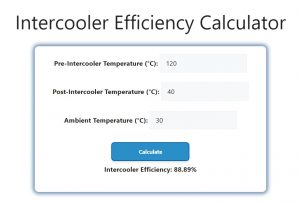About Intercooler Efficiency Calculator (Formula)
An intercooler plays a critical role in turbocharged and supercharged engines by cooling the air before it enters the combustion chamber. Lowering the temperature of the air increases its density, allowing for more oxygen to enter, which in turn boosts engine efficiency and performance. The intercooler efficiency calculator helps determine how well your intercooler is performing by comparing the air temperatures before and after the intercooler.
Formula
The formula for calculating intercooler efficiency is:
Intercooler Efficiency (Eint) = ((Tpre – Tpost) / (Tpre – Tamb)) * 100
Where:
- Eint is the intercooler efficiency percentage.
- Tpre is the temperature of the air before the intercooler.
- Tpost is the temperature of the air after the intercooler.
- Tamb is the ambient air temperature.
- The result is multiplied by 100 to express the efficiency as a percentage.
How to Use
- Measure Tpre: Use a temperature sensor to measure the temperature of the air before it enters the intercooler.
- Measure Tpost: Measure the air temperature after it passes through the intercooler.
- Record Tamb: Measure the ambient air temperature surrounding the intercooler.
- Input Values into the Calculator: Enter the measured values into the intercooler efficiency calculator.
- Calculate Intercooler Efficiency: The calculator will output the efficiency percentage, showing how well the intercooler is cooling the air.
Example
Let’s calculate intercooler efficiency with the following values:
- Tpre (air temperature before the intercooler) = 120°C
- Tpost (air temperature after the intercooler) = 40°C
- Tamb (ambient air temperature) = 30°C
Eint = ((120 – 40) / (120 – 30)) * 100
Eint = (80 / 90) * 100
Eint = 88.9%
This means the intercooler is 88.9% efficient in cooling the air.

FAQs
- What is intercooler efficiency?
Intercooler efficiency measures how effectively an intercooler reduces the temperature of compressed air before it enters the engine. - Why is intercooler efficiency important?
Higher efficiency means cooler air enters the engine, leading to better performance and fuel combustion, which increases power output. - How is intercooler efficiency calculated?
Intercooler efficiency is calculated by comparing the temperature drop across the intercooler relative to the ambient air temperature. - What factors affect intercooler efficiency?
Factors such as intercooler size, design, airflow, and ambient temperature can all influence efficiency. - What is a good efficiency value for an intercooler?
An efficiency rating of 70-90% is considered good for most intercoolers in high-performance applications. - Can intercooler efficiency improve engine performance?
Yes, a more efficient intercooler allows denser air to enter the engine, improving combustion and overall power output. - What happens if an intercooler is inefficient?
An inefficient intercooler leads to higher intake air temperatures, reducing engine performance and possibly causing engine knock. - Does intercooler efficiency vary with driving conditions?
Yes, efficiency can change depending on factors like vehicle speed, outside air temperature, and the amount of heat generated by the engine. - What is the ideal placement for an intercooler?
Intercoolers are typically placed in the front of the vehicle where airflow is maximized to improve cooling efficiency. - Can increasing intercooler size improve efficiency?
A larger intercooler can improve efficiency by providing more surface area for heat exchange, but excessive size may lead to pressure drop issues. - How do I know if my intercooler is functioning correctly?
Regularly measuring the air temperatures before and after the intercooler can help determine if it’s working as expected. - Does ambient temperature affect intercooler efficiency?
Yes, lower ambient temperatures increase intercooler efficiency because the temperature differential between intake air and ambient air is greater. - What are the benefits of a water-cooled intercooler?
Water-cooled intercoolers often have higher cooling efficiency, especially in vehicles with limited airflow or in hot environments. - Can intercooler efficiency be improved with modifications?
Yes, upgrades like better airflow management, increased surface area, and improved cooling techniques can enhance intercooler efficiency. - Does altitude affect intercooler efficiency?
Higher altitudes reduce air density, which can lower the intercooler’s cooling capacity, but efficiency can still remain high if designed correctly. - What materials are commonly used for intercoolers?
Most intercoolers are made from aluminum, as it is lightweight and has good thermal conductivity. - How does air-to-air intercooler efficiency compare to air-to-water intercoolers?
Air-to-water intercoolers can offer higher efficiency but may be more complex and heavier than air-to-air systems. - Can a damaged intercooler affect efficiency?
Yes, physical damage or clogging can reduce airflow and lower the intercooler’s effectiveness, leading to reduced performance. - What are common signs of intercooler inefficiency?
Increased intake air temperature, reduced engine power, and higher fuel consumption can all indicate a less efficient intercooler. - Can intercooler efficiency affect fuel economy?
Yes, better intercooler efficiency can lead to more efficient combustion, which may improve fuel economy, especially in turbocharged engines.
Conclusion
The Intercooler Efficiency Calculator is a valuable tool for assessing how well your intercooler cools the air before it enters the engine. By using the formula Eint = ((Tpre – Tpost) / (Tpre – Tamb)) * 100, you can determine the efficiency as a percentage. Ensuring your intercooler is working efficiently can lead to better engine performance, fuel economy, and reliability, making it an important consideration for turbocharged and supercharged vehicles.